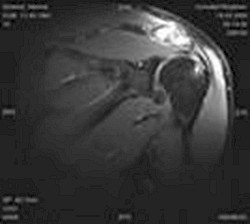
Arthrosis Acromioclavicular (AC) Joint - Acromioclavicular Joint - Osteoarthritis - ACG Osteoarthritis – Acromioclavicular - "Wear-and-Tear" of Joints
Shoulder pain during or after sport, pain when laying on the shoulder– these are symptoms that indicate precisely in younger patients wear of the acromioclavicular joint. Intensive stressful sports often lead to chronic wear of the acromioclavicular joint with the result of osteoarthritis.
Anatomy: Acromioclavicular joint
In addition to the main shoulder joint, e.g. the humeral head and the socket in which it moves, there is a small but very important joint, called the acromioclavicular joint or in short AC joint.
The AC joint is the articulate connection between the outer end of the collarbone (clavicle) and the acromion (part of the scapula that forms the highest point of the shoulder); the intervertebral disc, the so-called "discus" functioning as a buffer, is located between the cartilage surfaces. The AC joint, a very tight joint, is surrounded by a strong joint capsule. It is additionally stabilized by the coracoclavicular ligaments.
Symptoms: Acromioclavicular arthrosis
The wear and tear of the shoulder joint causes pain in the front part of the shoulder in particular when the shoulder is intensely strained. Often wear of the acromioclavicular joint also causes pain when lying on the shoulder. The pain is usually a rather dull-pulling feeling. Often there is also a clear pressure pain, and in advanced osteoarthritis, a swelling of the acromioclavicular joint.
Causes: Acromioclavicular arthrosis
Chronic strain and injuries, recurrent minor trauma or a violent fall on the shoulder (acromioclavicular blow) can cause premature wear of the acromioclavicular joint leading to osteoarthritis. This will initially cause a destruction of the buffer located between the articular surfaces. Subsequently, the cartilaginous joint surfaces of the clavicle and the acromion bone are damaged until they are eventually completely worn and bone is grinding against bone.
Diagnosis: Acromioclavicular osteoarthritis
In addition to a comprehensive examination of the shoulder together with the appropriate tests, the suspected diagnosis " acromioclavicular arthrosis" can be ascertained by an X-ray and ultrasound, but even more clearly by magnetic resonance imaging (MRI).
Conservative treatment: Acromioclavicular arthrosis
Problems occurring in the context of osteoarthritis of the shoulder joint should first be treated conservative i.e. non-surgically. Apart from a certain protection and cooling of the joint with cold packs, in an acutely painful phase, a short-term treatment with anti-inflammatory drugs (diclofenac / ibuprofen) as an ointment or in tablet from may be useful.
Significantly more effective is a local injection directly to the joint with a corticosteroid drug. If the symptoms are significantly improved with the injection, injections of hyaluronic acid administered three to five times at intervals of one week, can effect a long-term improvement of symptoms.
Surgical treatment: Acromioclavicular arthrosis
If conservative treatment does not lead to the desired improvement, osteoarthritis of acromioclavicular joint can be treated very successfully by arthroscopy, meaning a minimally invasive surgery. Arthroscopy is a very gentle surgical technique in which the shoulder specialist performs the surgery through two to three millimeter incisions using a miniature optics and the smallest surgical instruments.
Often osteoarthritis of the acromioclavicular joint is accompanied by narrowed subacromial space of the tendons below the acromion (impingement syndrome). In this case, the subacrominial space should be extended at the same time to prevent an otherwise impending tendon rupture (rupture rotator cuff).
Anesthesia: Surgery acromioclavicular arthrosis / arthroscopy shoulder
An arthroscopic shoulder surgery does require general anesthesia. What kind of anesthesia is necessary must be decided case by case and requires a comprehensive examination of the patient by the anesthesiologist.
General anesthesia is often combined with a local anesthesia of the nerve plexus (plexus cervicalis) at the shoulder. This combined anesthesia calls for less medication in the general anesthesia and can thus be tolerated better by the patient.
Postoperative: Surgery Acromioclavicular arthrosis / arthroscopy shoulder
Following arthroscopic surgery of acromioclavicular osteoarthritis, it is essential to mobilize the shoulder as soon as possible. Immobilization by keeping the arm in a sling is not required.
While for the healing process to run smoothly and within the appropriate time, a certain protection is initially necessary, the patient can move his/her shoulder gently soon after the surgery. During the first two to three weeks after the procedure, appropriate physiotherapy will support the recovery process. Additionally, medication that reduces the swelling and anti-inflammatory drugs (for example, ibuprofen 3x 2 x 75mg per day 600 mg per day or diclofenac) should be taken during the initial phase.
For pain management a regular cooling of the shoulder with ice packs is usually helpful. Long-term medication to relieve the pain is usually not necessary. As a rule, the patient can take up light daily activities and operate a car two to three days after the procedure.
Prognosis: Surgery acromioclavicular joint
In the hands of experienced shoulder specialists, the cause of shoulder pain, degenerative arthritis / osteoarthritis is treated safely and successfully by arthroscopic surgery. Scientific studies show that the vast majority of patients are very satisfied with the result and are permanently free of symptoms. A recurrence of osteoarthritis is not expected. Complications as a result of an arthroscopic treatment of acromioclavicular osteoarthritis are very rare.
Specialists: Acromioclavicular arthrosis
For an optimal treatment of acromioclavicular arthrosis/osteoarthritis, the shoulder experts at the Klinik am Ring are particularly well-qualified. Stefan Preis, M.D. and Jörg Schroeder, M.D., senior physicians at the Practice and Department of Orthopedics and Sports Traumatology at the Klinik am Ring in Cologne, specialize together with their team in the treatment of knee and shoulder disorders. In 2004, they founded the WEST GERMAN SHOULDER KNEE & CENTER, Cologne. The team consisting of eight specialists treats more than 10,000 patients per year. The team performs more than 2500 knee and shoulder surgeries per year of which are meantime several hundred surgeries are surgeries of the acromioclavicular joint.



